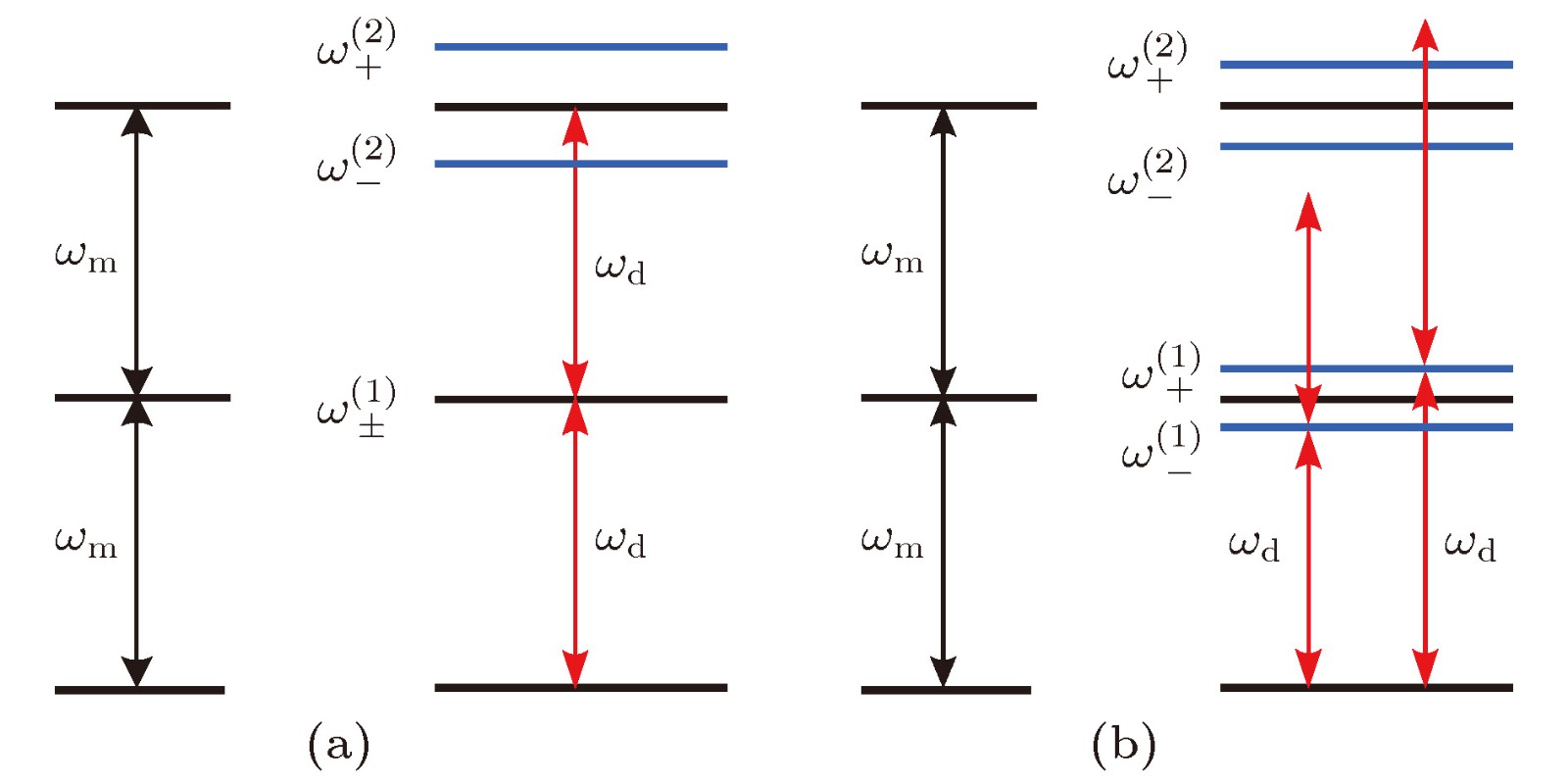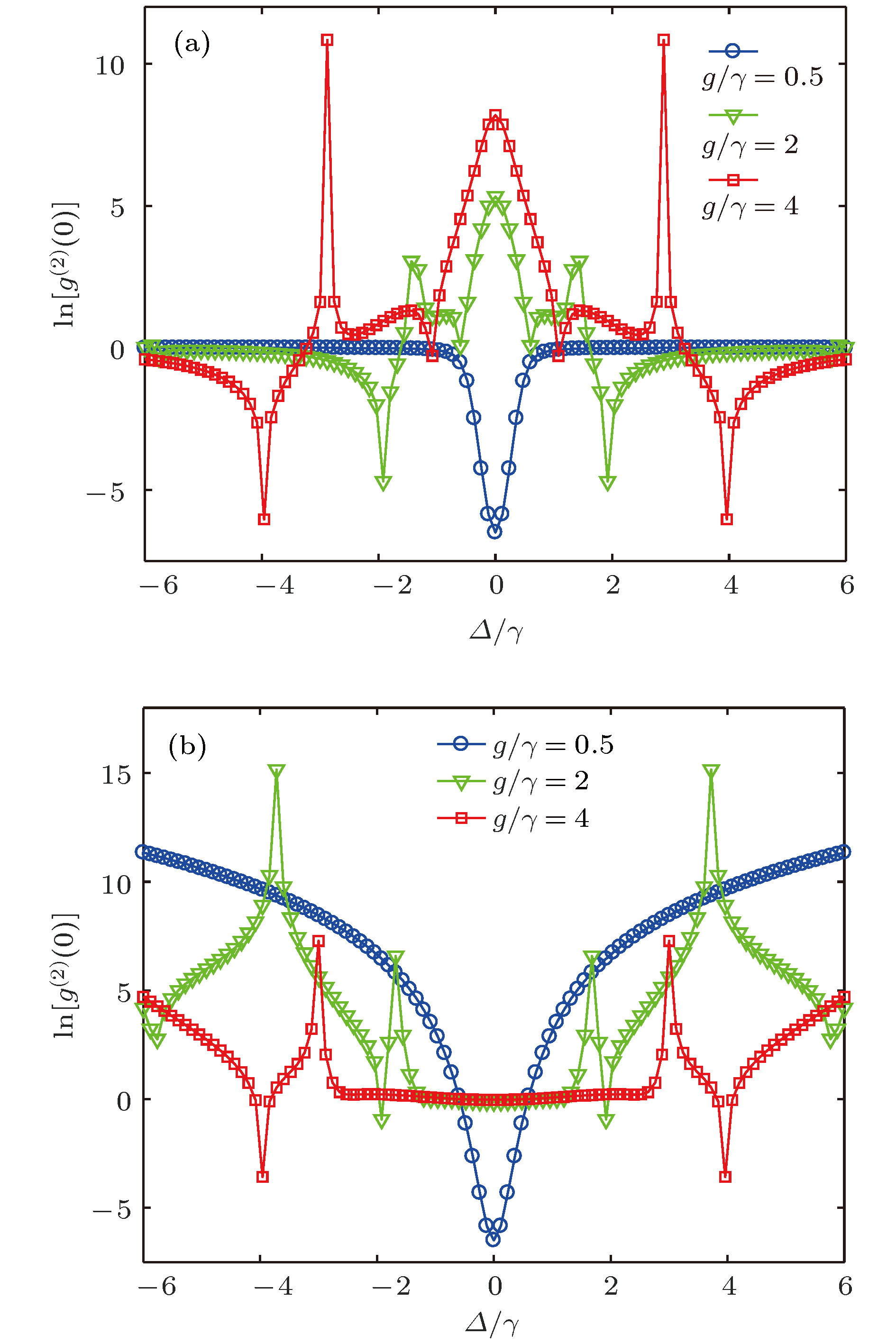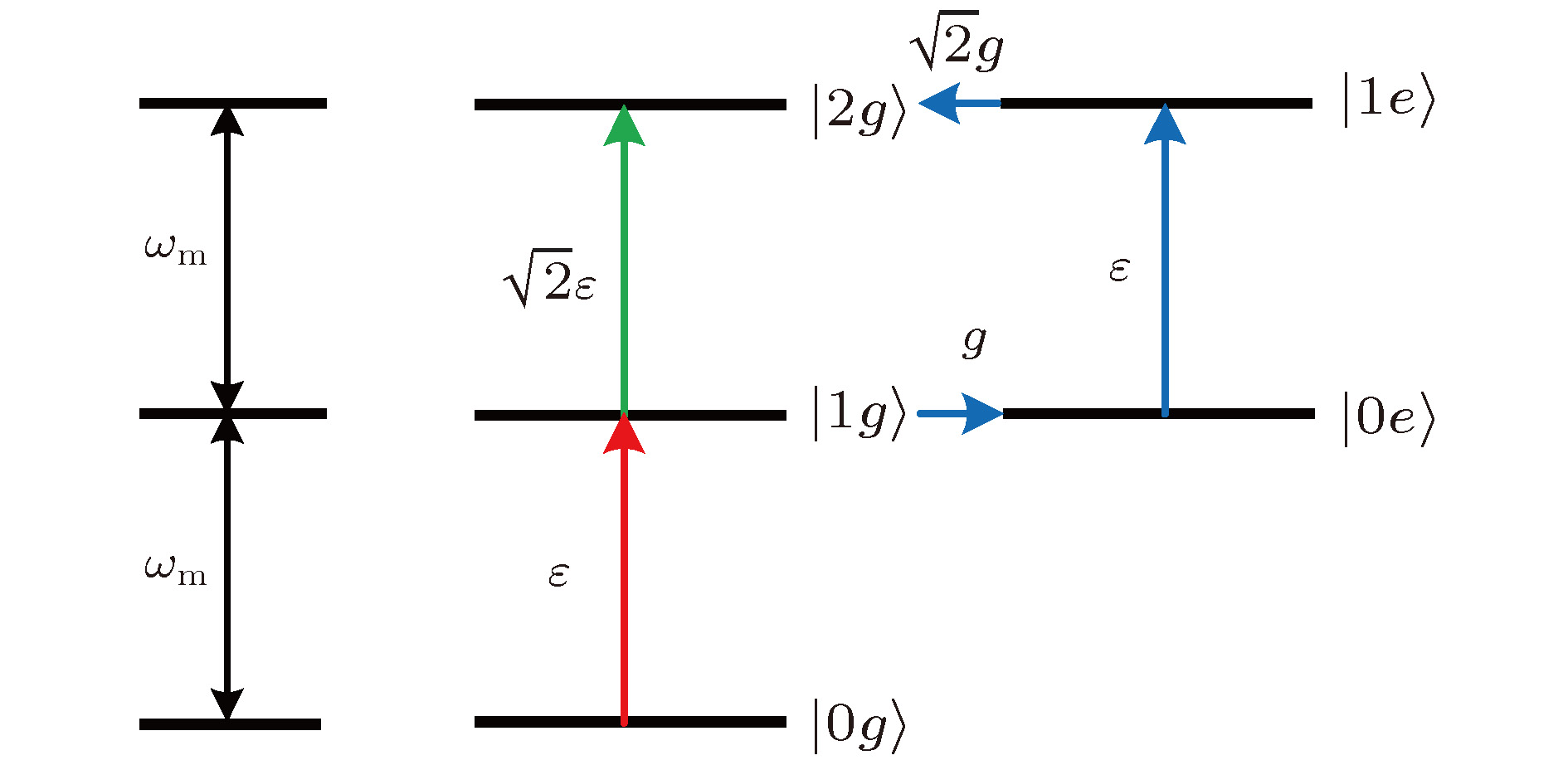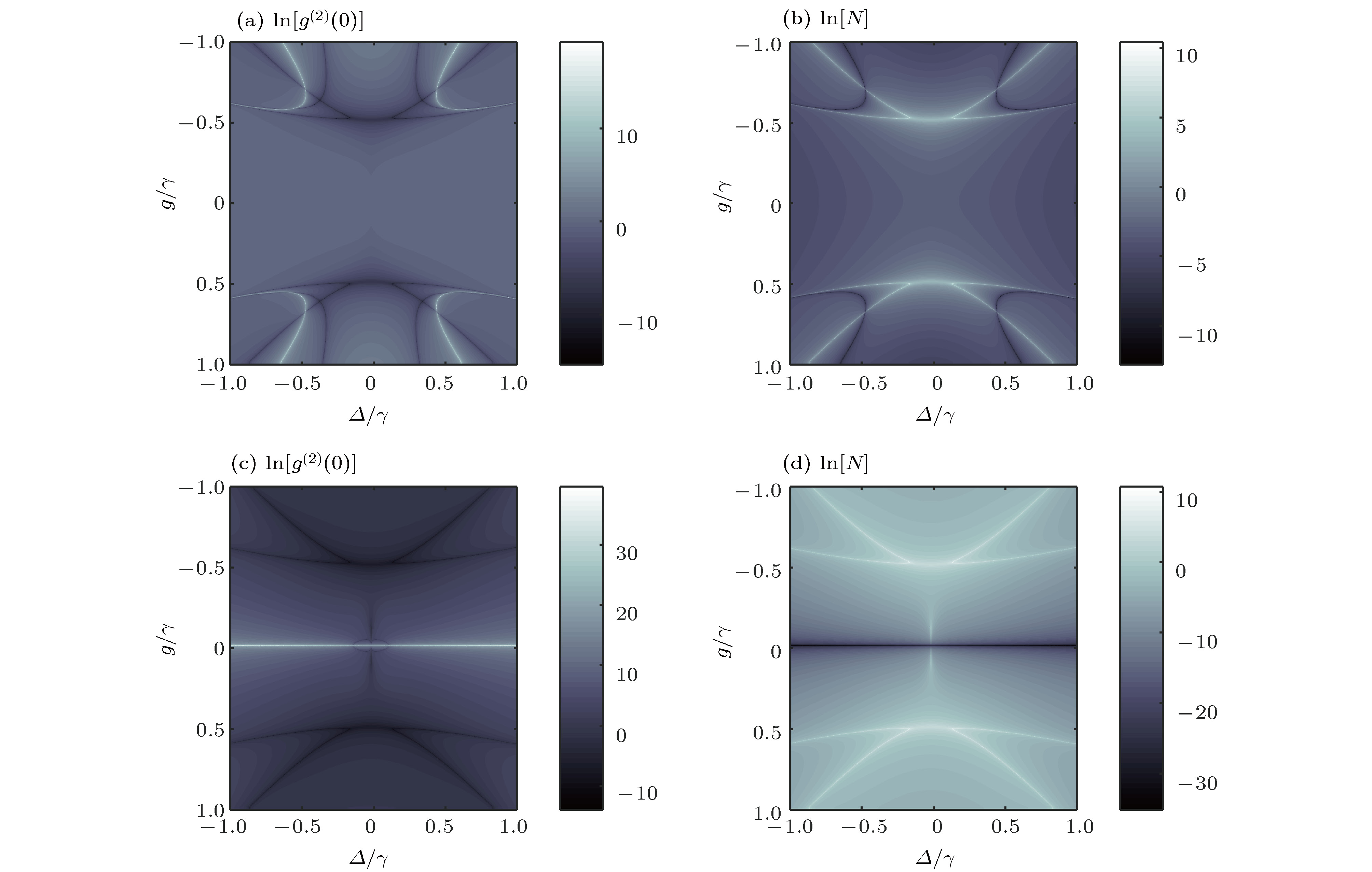-
Nanomechanical resonator has important applications in the field of high-precision detection because it has a high-Q factor, high vibration frequency, small size, and other excellent characteristics. Superconducting qubit has very large magnetic dipole moments, so it can be easily combined with nanomechanical resonator. Furthermore, the system parameters including frequency and coupling strength can be designed according to requirements beforehand, which makes a superconducting qubit an ideal artificial atom. Compared with natural atom, superconducting qubit has abundant energy levels. For these reasons, nanomechanical system has aroused wide interest in the engineering, electron, physical and other fields of science and technology. According to the recent research, a new approach to the zero eigenvalues of non-Hermitian Hamiltonian is applied to the optomechanical system. It was found that the scheme is superior to conventional photon blockade (CPB) and unconventional photon blockade (UPB) in the cavity quantum electrodynamics (QED) system. So we propose a scheme to induce phonon blockade in order to explore a new avenue to the research about phonon blockades in the quantum open system. We study the phonon blockade in an optomechanical system that a qubit is coupled with nanomechanical resonator (NAMR) driven by two external weakly driving fields respectively in this way. In this paper, the Hamiltonian of such a system can be treated by the non-Hermitian Hamiltonian and it can be described in the form of matrix. Then the phenomenon of phonon blockade occurs when all the eigenvalues in the form of matrix are equal to zero. It is found that strong phonon antibunching can be triggered in both strong and weak nonlinearity when we use the method which has been already used in a gain optical cavity system. The distinct result reflects the advantage of our approach which possesses some outstanding characters between the ordinary methods (conventional phonon blockade and unconventional phonon blockade). In addition, the effect of our avenue on phonon blockade is analyzed and also the distinction between the conventional phonon blockade (CPNB) and unconventional phonon blockade (UPNB) is compared with each other in detail. By analytical calculation, the optimal conditions are given and the underlying physical mechanism is explained. In the comparison between CPNB and UPNB, we show the superiority of our scheme through some graphs. Finally, we describe briefly the measurements of phonon blockade in the NAMR-qubit system via a superconducting cavity. The proposal may provide a theoretical way to guide the manufacture of phonon devices in the future. The results obtained here may have a great significance and application in the field of quantum information processing and precision measurement.
-
Keywords:
- phonon blockade /
- nanomechanical resonator /
- qubit
[1] You J Q, Nori F 2011 Nature 474 589
 Google Scholar
Google Scholar
[2] Armour A D, Blencowe M P, Schwab K C 2002 Phys. Rev. Lett. 88 148301
 Google Scholar
Google Scholar
[3] Blencowe M 2004 Phys. Rep. 395 159
 Google Scholar
Google Scholar
[4] Cleland A N, Geller M R 2004 Phys. Rev. Lett. 93 070501
 Google Scholar
Google Scholar
[5] O'Connell A D, Hofheinz M, Ansmann M, Bialczak R C, Lenander M, Lucero E, Neeley M, Sank D, Wang H, Weides M, Wenner J, Martinis J M, Cleland A N 2010 Nature 464 697
 Google Scholar
Google Scholar
[6] Liu Y X, Miranowicz A, Gao Y B, Bajer J, Sun C P, Nori F 2010 Phys. Rev. A 82 032101
 Google Scholar
Google Scholar
[7] Imamoglu A, Schmidt H, Woods G, Deutsch M 1997 Phys. Rev. Lett. 79 1467
 Google Scholar
Google Scholar
[8] Barzanjeh S, Vitali D 2016 Phys. Rev. A 93 033846
 Google Scholar
Google Scholar
[9] Zhou Y H, Shen H Z, Yi X X 2015 Phys. Rev. A 92 023838
 Google Scholar
Google Scholar
[10] Zhou Y H, Shen H Z, Shao X Q, Yi X X 2016 Opt. Express 24 17332
 Google Scholar
Google Scholar
[11] 石海泉, 谢智强, 徐勋卫, 刘念华 2018 67 044203
 Google Scholar
Google Scholar
Shi H Q, Xie Z Q, Xu X W, Liu N H 2018 Acta Phys. Sin. 67 044203
 Google Scholar
Google Scholar
[12] Cai K, Pan Z W, Wang R X, Ruan D, Yin Z Q, Long G L 2018 Opt. Lett. 43 1163
 Google Scholar
Google Scholar
[13] Miranowicz A, Bajer J, Lambert N, Liu Y X, Nori F 2016 Phys. Rev. A 93 013808
 Google Scholar
Google Scholar
[14] Wang X, Miranowicz A, Li H R, Nori F 2016 Phys. Rev. A 93 063861
 Google Scholar
Google Scholar
[15] Ramos T, Sudhir V, Stannigel K, Zoller P, Kippenberg T J 2013 Phys. Rev. Lett. 110 193602
 Google Scholar
Google Scholar
[16] Xu X W, Chen A X, Liu Y X 2016 Phys. Rev. A 94 063853
 Google Scholar
Google Scholar
[17] Gerace D, Savona V 2014 Phys. Rev. A 89 031803
 Google Scholar
Google Scholar
[18] Lemonde M A, Didier N, Clerk A A 2014 Phys. Rev. A 90 063824
 Google Scholar
Google Scholar
[19] Bamba M, Imamoğlu A, Carusotto I, Ciuti C 2011 Phys. Rev. A 83 021802
 Google Scholar
Google Scholar
[20] Qian Z, Zhao M M, Hou B P, Zhao Y H 2017 Opt. Express 25 33097
 Google Scholar
Google Scholar
[21] Shi H Q, Zhou X T, Xu X W, Liu N H 2018 Sci. Rep. 2018 2212
[22] Kong C, Li S, You C, Xiong H, Wu Y 2018 Sci. Rep. 8 1060
 Google Scholar
Google Scholar
[23] Li G, Xiao X, Li Y, Wang X 2018 Phys. Rev. A 97 023801
 Google Scholar
Google Scholar
[24] Guan S, Bowen W P, Liu C, Duan Z 2017 EPL 119 58001
 Google Scholar
Google Scholar
[25] Xie H, Liao C G, Shang X, Ye M Y, Lin X M 2017 Phys. Rev. A 96 013861
 Google Scholar
Google Scholar
[26] Yin T S, Lu X Y, Wan L L, Bin S W, Wu Y 2018 Opt. Lett. 43 2050
 Google Scholar
Google Scholar
[27] Debnath S, Linke N M, Wang S T, Figgatt C, Landsman K A, Duan L M, Monroe C 2018 Phys. Rev. Lett. 120 073001
 Google Scholar
Google Scholar
[28] Li S S 2018 Int. J. Theor. Phys. 57 2359
 Google Scholar
Google Scholar
[29] Shen H, Zhen B, Fu L 2018 Phys. Rev. Lett. 120 146402
 Google Scholar
Google Scholar
[30] Longhi S 2017 J. Phys. A: Math. Theor. 50 505201
 Google Scholar
Google Scholar
[31] Park K W, Kim J, Jeong K 2016 Opt. Commun. 368 190
 Google Scholar
Google Scholar
[32] Khantoul B, Bounames A, Maamache M 2017 Eur. Phys. J. Plus 132 258
 Google Scholar
Google Scholar
[33] Baradaran M, Panahi H 2017 Chin. Phys. B 26 060301
 Google Scholar
Google Scholar
[34] Maamache M, Lamri S, Cherbal O 2017 Ann. Phys. 378 150
 Google Scholar
Google Scholar
[35] Sergi A, Giaquinta P 2016 Entropy 18 451
 Google Scholar
Google Scholar
[36] Miao Y G, Xu Z M 2016 Phys. Lett. A 380 1805
 Google Scholar
Google Scholar
[37] Ferry D K, Akis R, Burke A M, Knezevic I, Brunner R, Bird J P, Meisels R, Kuchar F, Bird J P 2013 Fortschr. Phys. 61 291
 Google Scholar
Google Scholar
[38] Sergi A, Zloshchastiev K G 2016 J. Stat. Mech: Theory Exp. 2016 033102
 Google Scholar
Google Scholar
[39] Chen J H, Fan H Y 2012 Front. Phys. 7 632
 Google Scholar
Google Scholar
[40] Greenberg Y S, Shtygashev A A 2015 Phys. Rev. A 92 063835
 Google Scholar
Google Scholar
[41] Zloshchastiev K G 2015 Eur. Phys. J. D 69 253
 Google Scholar
Google Scholar
[42] Bagarello F, Lattuca M, Passante R, Rizzuto L, Spagnolo S 2015 Phys. Rev. A 91 042134
 Google Scholar
Google Scholar
[43] Giusteri G G, Mattiotti F, Celardo G L 2015 Phys. Rev. B 91 094301
 Google Scholar
Google Scholar
[44] Zhou Y H, Shen H Z, Zhang X Y, Yi X X 2018 Phys. Rev. A 97 043819
 Google Scholar
Google Scholar
[45] Li J, Yu R, Wu Y 2015 Phys. Rev. A 92 053837
 Google Scholar
Google Scholar
[46] Xing Y, Qi L, Cao J, Wang D Y, Bai C H, Wang H F, Zhu A D, Zhang S 2017 Phys. Rev. A 96 043810
 Google Scholar
Google Scholar
[47] Peng B, Ozdemir S K, Rotter S, Yilmaz H, Liertzer M, Monifi F, Bender C M, Nori F, Yang L 2014 Science 346 328
 Google Scholar
Google Scholar
[48] Chang L, Jiang X, Hua S, Yang C, Wen J, Jiang L, Li G, Wang G, Xiao M 2014 Nat. Photonics 8 524
 Google Scholar
Google Scholar
[49] Hodaei H, Miri M A, Heinrich M, Christodoulides D N, Khajavikhan M 2014 Science 346 975
 Google Scholar
Google Scholar
[50] Peng B, Özdemir Ş K, Lei F, Monifi F, Gianfreda M, Long G L, Fan S, Nori F, Bender C M, Yang L 2014 Nat. Phys. 10 394
 Google Scholar
Google Scholar
[51] Feng L, Wong Z J, Ma R M, Wang Y, Zhang X 2014 Science 346 972
 Google Scholar
Google Scholar
[52] Fan L R, Fong K Y, Poot M, Tang H X 2015 Nat. Commun. 6 5850
[53] Xiong C, Fan L R, Sun X K, Tang H X 2013 Appl. Phys. Lett 102 021110
[54] Winger M, Blasius T D, Alegre T P M, Safavi Naeini A H, Meenehan S, Cohen J, Stobbe S, Painter O 2011 Opt. Express 19 24905
 Google Scholar
Google Scholar
[55] Zhang J, Peng B, Ozdemir S K, Liu Y X, Jing H, Lu X Y, Liu Y L, Yang L, Nori F 2015 Phys. Rev. B 92 115407
[56] Bahl G, Tomes M, Marquardt F, Carmon T 2012 Nat. Phys. 8 203
 Google Scholar
Google Scholar
[57] Dong C H, Shen Z, Zou C L, Zhang Y L, Fu W, Guo G C 2015 Nat. Commun. 6 6193
[58] Kepesidis K V, Milburn T J, Huber J, Makris K G, Rotter S, Rabl P 2016 New J. Phys. 18 095003
[59] Xu X W, Liu Y X, Sun C P, Li Y 2015 Phys. Rev. A 92 013852
[60] 刘玉龙2017 博士学位论文 (北京: 清华大学)
Liu Y L 2017 Ph. D. Dissertation (Beijing: Tsinghua University) (in Chinese)
[61] Didier N, Pugnetti S, Blanter Y M, Fazio R 2011 Phys. Rev. B 84 054503
 Google Scholar
Google Scholar
-
图 2 外加驱动场共振的情况下声子阻塞现象的能级图 (a)满足(8)式时的能级图, 其中
$\omega _ \pm ^{\left( 1 \right)} = {\omega _{\rm{m}}}$ 和$\omega _ \pm ^{\left( 2 \right)} = 2{\omega _{\rm{m}}} \pm $ $2g + {\rm{i}}\dfrac{\gamma }{2}$ ; (b)满足(9)式时的能级图, 其中$\omega _ \pm ^{\left( 1 \right)} = {\omega _{\rm{m}}} \pm g$ 和$\omega _ \pm ^{\left( 2 \right)} = 2{\omega _{\rm{m}}} \pm \sqrt 2 g + {\rm{i}}\dfrac{\gamma }{2}$ Fig. 2. Schematic energy-level diagram explaining the occurrence of the phonon blockade by the driving field satisfying the resonance condition: (a) Energy-level diagram when Eqs. (8) are satisfied, where
$\omega _ \pm ^{\left( 1 \right)} = {\omega _{\rm{m}}}$ and$\omega _ \pm ^{\left( 2 \right)} = 2{\omega _{\rm{m}}} \pm$ $ 2g + {\rm{i}}\dfrac{\gamma }{2}$ ; (b) energy-level diagram when Eqs. (9) are satisfied, where$\omega _ \pm ^{\left( 1 \right)} = {\omega _{\rm{m}}} \pm g$ and$\omega _ \pm ^{\left( 2 \right)} = 2{\omega _{\rm{m}}} \pm \sqrt 2 g + {\rm{i}}\dfrac{\gamma }{2}$ .图 3 在不同的
$g/\gamma $ 关系下, 二阶关联函数${g^{\left( 2 \right)}}\left( 0 \right)$ 与$\varDelta /\gamma $ 的关系图 (a)$\kappa /\gamma = - 1$ ,$\varepsilon /\gamma = 0.1$ ,$\varOmega = 0$ ,$\varepsilon \ne 0$ ; (b)$\kappa /\gamma = - 1$ ,$\varOmega /\gamma = 0.1$ ,$\varepsilon = 0$ ,$\phi = 0$ Fig. 3. Logarithmic plot (of base e) of the zero-delay-time second-order correlation functions
${g^{\left( 2 \right)}}\left( 0 \right)$ as a function of$\varDelta /\gamma $ for different$g/\gamma $ with$\kappa /\gamma = - 1$ : (a)$\varepsilon /\gamma = 0.1$ ,$\varOmega = 0$ ,$\varepsilon \ne 0$ ; (b)$\varOmega /\gamma = 0.1$ ,$\varepsilon = 0$ ,$\phi = 0$ .图 6 二阶关联函数
${g^{\left( 2 \right)}}\left( 0 \right)$ 和平均声子数$N = \left\langle {{a^ + }a} \right\rangle = \left[ {{\rm{Tr}}\left( {{\rho _s}{a^ + }a} \right)} \right]$ 的对数图像 (a), (b)$\varepsilon /\gamma = 0.1$ ,$\varOmega = 0$ ; (c), (d)$\varOmega /\gamma = 0.1$ ,$\varepsilon = 0$ ,$\phi = 0$ . 其他参数为$\kappa /\gamma = - 1$ .Fig. 6. The logarithmic plot (of base e) of the zero-delay-time second-order correlation functions
${g^{\left( 2 \right)}}\left( 0 \right)$ and average photon numberN: (a) and (b)$\varepsilon /\gamma = 0.1$ ,$\varOmega = 0$ ; (c) and (d)$\varOmega /\gamma = 0.1$ ,$\varepsilon = 0$ ,$\phi = 0$ . The shared parameters:$\kappa /\gamma = - 1$ .图 7 二阶关联函数
${g^{\left( 2 \right)}}\left( 0 \right)$ (对数)与$\varDelta /\gamma $ 的关系图, 其中$\varepsilon /\gamma = 0.1$ ,$\varOmega = 0$ (a)$g/\gamma = 0.5$ ,$\kappa /\gamma = - 1$ (本文方案),$\kappa /\gamma = 1$ (UPNB); (b)$g/\gamma = 5$ ,$\kappa /\gamma = - 1$ (本文方案),$\kappa /\gamma = 1$ (CPNB)Fig. 7. The logarithmic plot (of base e) of the zero-delay-time second-order correlation functions
${g^{\left( 2 \right)}}\left( 0 \right)$ as a function of$\varDelta /\gamma $ . The shared parameters:$\varepsilon /\gamma = 0.1$ ,$\varOmega = 0$ . Other parameters: (a)$g/\gamma = 0.5$ ,$\kappa /\gamma = - 1$ (our scheme),$\kappa /\gamma = 1$ (UPNB); (b)$g/\gamma = 5$ ,$\kappa /\gamma = - 1$ (our scheme),$\kappa /\gamma = 1$ (CPNB).图 8 二阶关联函数
${g^{\left( 2 \right)}}\left( 0 \right)$ (对数)与$\varDelta /\gamma $ 的关系图,$\varOmega \ne 0$ ,$\varepsilon = 0$ ,$\phi = 0$ (a)$\varOmega /\gamma = 0.1$ ,$g/\gamma = 0.5$ ,$\kappa /\gamma = - 1$ (本文方案),$\kappa /\gamma = 1$ (UPNB); (b)$\varOmega /\gamma = 2$ ,$g/\gamma = 10$ ,$\kappa /\gamma = - 1$ (本文方案),$\kappa /\gamma = 1$ (CPNB)Fig. 8. The logarithmic plot (of base e) of the zero-delay-time second-order correlation functions
${g^{\left( 2 \right)}}\left( 0 \right)$ as a function of$\varDelta /\gamma $ :$\varOmega \ne 0$ ,$\varepsilon = 0$ ,$\phi = 0$ . Other parameters: (a)$\varOmega /\gamma = 0.1$ ,$g/\gamma = 0.5$ ,$\kappa /\gamma = - 1$ (our scheme),$\kappa /\gamma = 1$ (UPNB); (b)$\varOmega /\gamma = 2$ ,$g/\gamma = 10$ ,$\kappa /\gamma = - 1$ (our scheme),$\kappa /\gamma = 1$ (CPNB). -
[1] You J Q, Nori F 2011 Nature 474 589
 Google Scholar
Google Scholar
[2] Armour A D, Blencowe M P, Schwab K C 2002 Phys. Rev. Lett. 88 148301
 Google Scholar
Google Scholar
[3] Blencowe M 2004 Phys. Rep. 395 159
 Google Scholar
Google Scholar
[4] Cleland A N, Geller M R 2004 Phys. Rev. Lett. 93 070501
 Google Scholar
Google Scholar
[5] O'Connell A D, Hofheinz M, Ansmann M, Bialczak R C, Lenander M, Lucero E, Neeley M, Sank D, Wang H, Weides M, Wenner J, Martinis J M, Cleland A N 2010 Nature 464 697
 Google Scholar
Google Scholar
[6] Liu Y X, Miranowicz A, Gao Y B, Bajer J, Sun C P, Nori F 2010 Phys. Rev. A 82 032101
 Google Scholar
Google Scholar
[7] Imamoglu A, Schmidt H, Woods G, Deutsch M 1997 Phys. Rev. Lett. 79 1467
 Google Scholar
Google Scholar
[8] Barzanjeh S, Vitali D 2016 Phys. Rev. A 93 033846
 Google Scholar
Google Scholar
[9] Zhou Y H, Shen H Z, Yi X X 2015 Phys. Rev. A 92 023838
 Google Scholar
Google Scholar
[10] Zhou Y H, Shen H Z, Shao X Q, Yi X X 2016 Opt. Express 24 17332
 Google Scholar
Google Scholar
[11] 石海泉, 谢智强, 徐勋卫, 刘念华 2018 67 044203
 Google Scholar
Google Scholar
Shi H Q, Xie Z Q, Xu X W, Liu N H 2018 Acta Phys. Sin. 67 044203
 Google Scholar
Google Scholar
[12] Cai K, Pan Z W, Wang R X, Ruan D, Yin Z Q, Long G L 2018 Opt. Lett. 43 1163
 Google Scholar
Google Scholar
[13] Miranowicz A, Bajer J, Lambert N, Liu Y X, Nori F 2016 Phys. Rev. A 93 013808
 Google Scholar
Google Scholar
[14] Wang X, Miranowicz A, Li H R, Nori F 2016 Phys. Rev. A 93 063861
 Google Scholar
Google Scholar
[15] Ramos T, Sudhir V, Stannigel K, Zoller P, Kippenberg T J 2013 Phys. Rev. Lett. 110 193602
 Google Scholar
Google Scholar
[16] Xu X W, Chen A X, Liu Y X 2016 Phys. Rev. A 94 063853
 Google Scholar
Google Scholar
[17] Gerace D, Savona V 2014 Phys. Rev. A 89 031803
 Google Scholar
Google Scholar
[18] Lemonde M A, Didier N, Clerk A A 2014 Phys. Rev. A 90 063824
 Google Scholar
Google Scholar
[19] Bamba M, Imamoğlu A, Carusotto I, Ciuti C 2011 Phys. Rev. A 83 021802
 Google Scholar
Google Scholar
[20] Qian Z, Zhao M M, Hou B P, Zhao Y H 2017 Opt. Express 25 33097
 Google Scholar
Google Scholar
[21] Shi H Q, Zhou X T, Xu X W, Liu N H 2018 Sci. Rep. 2018 2212
[22] Kong C, Li S, You C, Xiong H, Wu Y 2018 Sci. Rep. 8 1060
 Google Scholar
Google Scholar
[23] Li G, Xiao X, Li Y, Wang X 2018 Phys. Rev. A 97 023801
 Google Scholar
Google Scholar
[24] Guan S, Bowen W P, Liu C, Duan Z 2017 EPL 119 58001
 Google Scholar
Google Scholar
[25] Xie H, Liao C G, Shang X, Ye M Y, Lin X M 2017 Phys. Rev. A 96 013861
 Google Scholar
Google Scholar
[26] Yin T S, Lu X Y, Wan L L, Bin S W, Wu Y 2018 Opt. Lett. 43 2050
 Google Scholar
Google Scholar
[27] Debnath S, Linke N M, Wang S T, Figgatt C, Landsman K A, Duan L M, Monroe C 2018 Phys. Rev. Lett. 120 073001
 Google Scholar
Google Scholar
[28] Li S S 2018 Int. J. Theor. Phys. 57 2359
 Google Scholar
Google Scholar
[29] Shen H, Zhen B, Fu L 2018 Phys. Rev. Lett. 120 146402
 Google Scholar
Google Scholar
[30] Longhi S 2017 J. Phys. A: Math. Theor. 50 505201
 Google Scholar
Google Scholar
[31] Park K W, Kim J, Jeong K 2016 Opt. Commun. 368 190
 Google Scholar
Google Scholar
[32] Khantoul B, Bounames A, Maamache M 2017 Eur. Phys. J. Plus 132 258
 Google Scholar
Google Scholar
[33] Baradaran M, Panahi H 2017 Chin. Phys. B 26 060301
 Google Scholar
Google Scholar
[34] Maamache M, Lamri S, Cherbal O 2017 Ann. Phys. 378 150
 Google Scholar
Google Scholar
[35] Sergi A, Giaquinta P 2016 Entropy 18 451
 Google Scholar
Google Scholar
[36] Miao Y G, Xu Z M 2016 Phys. Lett. A 380 1805
 Google Scholar
Google Scholar
[37] Ferry D K, Akis R, Burke A M, Knezevic I, Brunner R, Bird J P, Meisels R, Kuchar F, Bird J P 2013 Fortschr. Phys. 61 291
 Google Scholar
Google Scholar
[38] Sergi A, Zloshchastiev K G 2016 J. Stat. Mech: Theory Exp. 2016 033102
 Google Scholar
Google Scholar
[39] Chen J H, Fan H Y 2012 Front. Phys. 7 632
 Google Scholar
Google Scholar
[40] Greenberg Y S, Shtygashev A A 2015 Phys. Rev. A 92 063835
 Google Scholar
Google Scholar
[41] Zloshchastiev K G 2015 Eur. Phys. J. D 69 253
 Google Scholar
Google Scholar
[42] Bagarello F, Lattuca M, Passante R, Rizzuto L, Spagnolo S 2015 Phys. Rev. A 91 042134
 Google Scholar
Google Scholar
[43] Giusteri G G, Mattiotti F, Celardo G L 2015 Phys. Rev. B 91 094301
 Google Scholar
Google Scholar
[44] Zhou Y H, Shen H Z, Zhang X Y, Yi X X 2018 Phys. Rev. A 97 043819
 Google Scholar
Google Scholar
[45] Li J, Yu R, Wu Y 2015 Phys. Rev. A 92 053837
 Google Scholar
Google Scholar
[46] Xing Y, Qi L, Cao J, Wang D Y, Bai C H, Wang H F, Zhu A D, Zhang S 2017 Phys. Rev. A 96 043810
 Google Scholar
Google Scholar
[47] Peng B, Ozdemir S K, Rotter S, Yilmaz H, Liertzer M, Monifi F, Bender C M, Nori F, Yang L 2014 Science 346 328
 Google Scholar
Google Scholar
[48] Chang L, Jiang X, Hua S, Yang C, Wen J, Jiang L, Li G, Wang G, Xiao M 2014 Nat. Photonics 8 524
 Google Scholar
Google Scholar
[49] Hodaei H, Miri M A, Heinrich M, Christodoulides D N, Khajavikhan M 2014 Science 346 975
 Google Scholar
Google Scholar
[50] Peng B, Özdemir Ş K, Lei F, Monifi F, Gianfreda M, Long G L, Fan S, Nori F, Bender C M, Yang L 2014 Nat. Phys. 10 394
 Google Scholar
Google Scholar
[51] Feng L, Wong Z J, Ma R M, Wang Y, Zhang X 2014 Science 346 972
 Google Scholar
Google Scholar
[52] Fan L R, Fong K Y, Poot M, Tang H X 2015 Nat. Commun. 6 5850
[53] Xiong C, Fan L R, Sun X K, Tang H X 2013 Appl. Phys. Lett 102 021110
[54] Winger M, Blasius T D, Alegre T P M, Safavi Naeini A H, Meenehan S, Cohen J, Stobbe S, Painter O 2011 Opt. Express 19 24905
 Google Scholar
Google Scholar
[55] Zhang J, Peng B, Ozdemir S K, Liu Y X, Jing H, Lu X Y, Liu Y L, Yang L, Nori F 2015 Phys. Rev. B 92 115407
[56] Bahl G, Tomes M, Marquardt F, Carmon T 2012 Nat. Phys. 8 203
 Google Scholar
Google Scholar
[57] Dong C H, Shen Z, Zou C L, Zhang Y L, Fu W, Guo G C 2015 Nat. Commun. 6 6193
[58] Kepesidis K V, Milburn T J, Huber J, Makris K G, Rotter S, Rabl P 2016 New J. Phys. 18 095003
[59] Xu X W, Liu Y X, Sun C P, Li Y 2015 Phys. Rev. A 92 013852
[60] 刘玉龙2017 博士学位论文 (北京: 清华大学)
Liu Y L 2017 Ph. D. Dissertation (Beijing: Tsinghua University) (in Chinese)
[61] Didier N, Pugnetti S, Blanter Y M, Fazio R 2011 Phys. Rev. B 84 054503
 Google Scholar
Google Scholar
计量
- 文章访问数: 9362
- PDF下载量: 113
- 被引次数: 0














 下载:
下载:




































































































